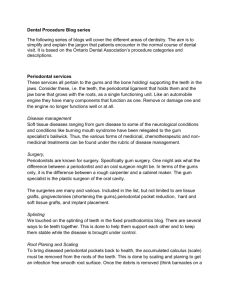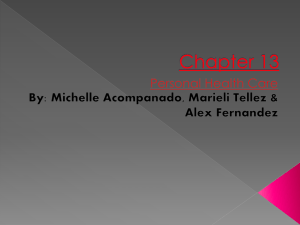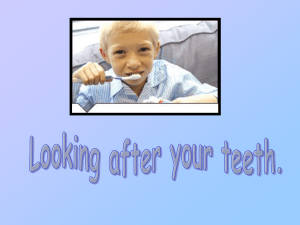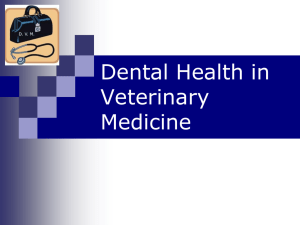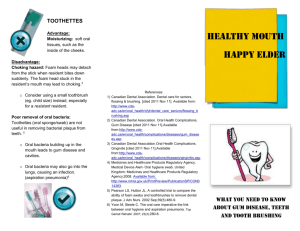Revision Guide
advertisement
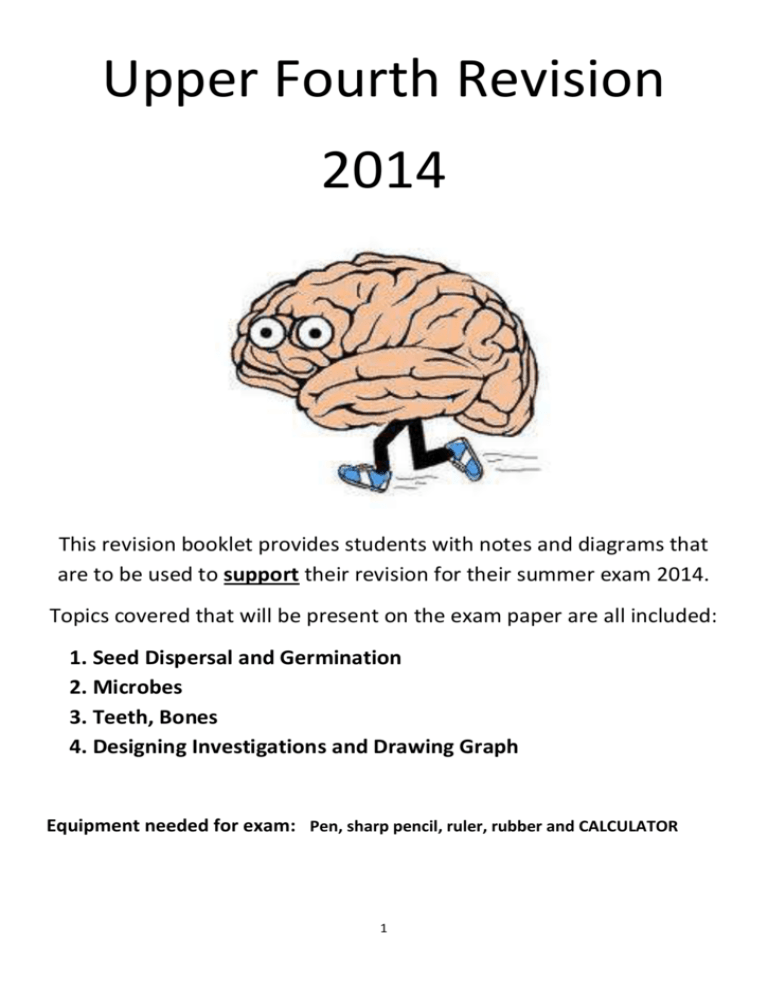
Upper Fourth Revision 2014 This revision booklet provides students with notes and diagrams that are to be used to support their revision for their summer exam 2014. Topics covered that will be present on the exam paper are all included: 1. Seed Dispersal and Germination 2. Microbes 3. Teeth, Bones 4. Designing Investigations and Drawing Graph Equipment needed for exam: Pen, sharp pencil, ruler, rubber and CALCULATOR 1 Topic 1 Seed Dispersal and Germination Types of seed dispersal Appreciate the importance of seed dispersal Avoid competition Increase chance of survival Factors needed for Germination The structure of a seed. Cotyledon: Energy store for germination Plumule: grows to become shoot Radical: grows to form room Testa: waterproof protection whilst seed is dormant 2 Water (to activate ENZYMES) Suitable temperature Light Oxygen Topic 2 Micro-Organisms Different types of microbes: Appreciate experiments carried out by various scientists to disprove spontaneous generation and support biogenesis. 3 • Biogenesis: The theory claims living things could only arise from living things. • The opposite of this theory is the spontaneous generation theory, which states that living things arise from nonliving things. Redi’s Investigation: • Louis Pasteur’s Investigation: • Micro-organisms can be harmful and cause disease (PATHOGEN). 4 5 6 7 Natural Defences of the body Use of Antibiotics 8 Use of Microbes in the Food and Drink Industry Cheese Making Fermenting Microbes are added to Pastuerised milk Bacteria produce an acid which causes milk to coagulate into curds (soid) and Whey (liquid) Curds serperated and treated with salt and flavouring Place in moulds and left to mature Making Yogurt Bacteria culture lactobacillus is added to milk Respiring bacteria produce lactic acid which causes milk to become sour 9 Brewing Industry Beer and wine are alcoholic drinks made by fermentation reactions that use yeast to convert sugars into ethanol. There are harmful effects and social problems because of ethanol in drinks. Sugar from plant material is converted into ethanol and carbon dioxide by fermentation. The enzymes found in single-celled fungi - yeast - are the natural catalysts that can make this process happen. Here are the word and balanced formulae equations: sugar → ethanol + carbon dioxide C6H12O6 2C2H5OH + 2CO2 10 Fermentation usually works best at around 37ºC. It is a slow process and several weeks or more are usually needed to produce an acceptable alcoholic drink. Beer The sugars for beer-making come from boiling barley in water. Hops are added to adjust the flavour of the beer. Wine The sugars for wine-making come from grape juice. Different varieties of grapes are used to produce wines with different flavours. Wine contains a higher proportion of ethanol than beer does, because grape juice contains a higher concentration of sugars than barley in water. Methods of Food preservation Method Advantages Disadvantages Drying (e.g. freeze-drying, spraydrying, sun-drying) Produces concentrated form of food. Can cause loss of some nutrients, particularly thiamin & vitamin C. Inhibits microbial growth & autolytic enzymes. Retains most nutrients. Sulphur dioxide is sometimes added to dried fruits to retain vitamin C, but some individuals are sensitive to this substance. Smoking Preserve partly by drying, partly by incorporation of substances from smoke. Eating a lot of smoked foods has been linked with some cancers in some parts of the world. Refrigeration Slows microbial multiplication. Slow loss of some nutrients with time Slows autolysis by enzymes Freezing Adding salt or sugar Prevents microbial growth by low temperature & unavailability of water. Blanching of vegetables prior to freezing causes loss of some BGroup vitamins and vitamin C. Generally good retention of nutrients. Unintended thawing can reduce product quality. Makes water unavailable for microbial growth. Increases salt and sugar content of food. Process does not destroy nutrients. High heat processing (e.g. pasteurisation) Inactivates autolytic enzymes Loss of heat-sensitive nutrients. Destroys microorganisms. Canning (involves high heat processing) Destroys microorganisms & autolytic enzymes. 11 Water-soluble nutrients can be lost into liquid in can. Topic 3 Teeth. Bones and Joints Tooth Decay (Cavities) Tooth decay can happen to anyone who has their own natural teeth in their mouths—no matter what age! Tooth decay is caused by bacteria that normally live in the mouth. These bacteria cling to teeth and form a sticky, colourless film called dental plaque. The bacteria in plaque live on sugars and produce decay-causing acids that 12 dissolve minerals on tooth surfaces. Tooth decay can also develop on the exposed roots of the teeth if you have gum disease or receding gums (Receding gums are gums that are pulling away from the teeth so that you can see the roots. Just as with children, fluoride is also important for adult teeth. Adding fluoride to the water can reduce tooth decay for all ages. Fluoride can also be added to mouth rinses and some toothpastes so it is wise to read labels carefully and buy mouthwashes and toothpastes that have added fluoride. Periodontal (Gum) Disease A common cause of tooth loss after age 35 is periodontal disease. These are infections of the gum and bone that hold the teeth in place. Gum diseases are also caused by dental plaque. The bacteria in plaque causes gums to become inflamed and bleed easily. If left untreated, the disease gets worse as pockets of infection form between the teeth and gums. This causes receding gums and loss of supporting bone. You may lose enough bone to cause your teeth to become loose and fall out. You can prevent gum disease by removing plaque. Thoroughly brush and floss your teeth each day. Carefully check your mouth for early signs of disease such as red, swollen or bleeding gums. See a dentist regularly—every 6 to 12 months or immediately you see any signs of gum disease! Tartar If plaque stays on the teeth for a while it forms a hard layer called tarter. Tartar has to be scraped off teeth by a dentist. Tartar build-up increases the risk of dental cavities. 13 The Skeleton 14 15 16 Designing Investigations and Drawing Graph Designing Investigations: C ORMS C Change O Organism R Repeats M Measurements S Same What are you changing in your investigation? Independent variable Are you using any organisms? What ethical consideration do you need to think of? Be nice to them! HOW many repeats are you going to do? Appreciate that repeats are necessary to ensure the results we are obtaining are reliable. You can calculate a mean/average result if you carry out repeats What measurements are you taking (time, length, mass etc) make sure you consider what units you are measuring in (i.e cm or mm?). Dependant variable What Variables are you keeping the same in your investigation. HOW and WHY? Graph Skills Always use a SHARP PENCIL Use suitable SCALE to your graph (use over a quarter of your graph paper) Your independent variable goes on your X AXIS You dependant variable goes on your Y AXIS Include UNITS used when labelling x/y axis Plot points using sharp PENCIL not pen Always provide suitable TITLE that incorporates both your x/y axis When drawing line graph you can use ruler to draw line between points unless you are asked to draw a line of best fit. SPLATUK 17 18


